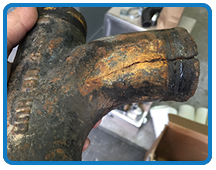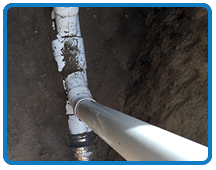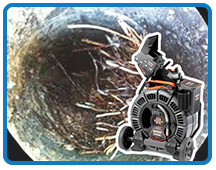sewer & water repair / replacement
cure in place pipe | sectional/point repair | excavation | pipe bursting
cure in place pipe (CIPP)
CIPP is quickly emerging as the preferred method to repair aging sewer & water lines. The technology allows for a 100% trenchless installation that requires zero disruption to yards, sidewalks, parking lots, store fronts, driveways, or streets. A resin-saturated liner is inverted into the existing line through a cleanout or incision made in the existing pipe. The resin hardens under an exothermic reaction and forms a pipe-within-a-pipe. Once cured, the existing sewer lateral will be rehabilitated to an additional 50 years of service.
SECTIONAL/POINT REPAIR (CIPP)
If a singular point of deficiency can be identified, we can install a point repair at that spot. Ranging in length from 24” to 96”, a fiberglass or felt repair can be installed at any point in the line. Our Hammerhead Trenchless and Trelleborg packers are Kevlar-reinforced for optimal pressure and curing during installation. Once the repair is ready, it is wrapped onto a packer. Fiberglass, dual purpose air/push rods are connected to the packer. The packer is now able to be remotely pushed or pulled in place until it has reached the deficiency. A small air compressor inflates the packer and holds the repair tight against the host-pie wall. 2-3 hours later, the packer is removed and the repair has been completed.
Excavation
Open trench excavation is the time-tested method for sewer & water repair. The proposed trench is located by white spray paint above-ground or within the foundation if trenching is needed inside. This is to identify to other utilities where the proposed trench will be. Once all interference is identified, traffic and pedestrian control is put in place for public safety. Full-depth excavation begins with excavation at the furthest point of deficiency and works towards the building. Once at the municipal building, a connection is made and your lateral has been replaced. Once inspected, the trench is backfilled. Depending on the season there will be landscaping, hardscaping, sidewalk, driveway, or potentially public streets that may need replacement.
Pipe Bursting
Pipe bursting is an alternative to open-trench excavation. The technology is sought as a semi-trenchless method due to the elimination of up to 90% of the trench. Pipe bursting requires two pits. Pit “A” (launch pit) is typically downstream from the repair and pit “B” (receiving pit) is typically upstream. Our Hammerhead Trenchless PortaBurst PB30 hydraulic bursting unit is dropped into pit A. The PB30 is used to pull 1-inch steel cable through the existing lateral. Once the cable reaches pit B, a bursting head is attached. The bursting head is one pipe-size larger than the pipe being replaced. The PB30 pulls the bursting head in reverse which fractures the existing pipe into the ground around it. New pipe is pulled into place behind the bursting head until all cable has been removed. This process allows for the preservation of parking lots, sidewalks, store fronts, etc. Once the burst is complete, the pits are backfilled and minimal site restoration is needed.




